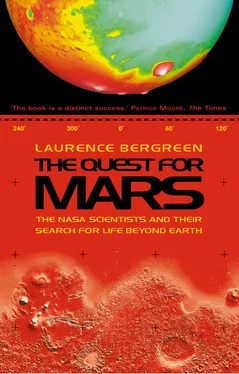Manning’s team conducted early Pathfinder landing tests at a NASA facility in Cleveland, Ohio, which featured a large vacuum chamber. Within, girders, lava rocks, and wood simulated the Martian surface. They dropped Pathfinder in its protective bubble onto the sharp objects and observed the result.
R-r-r-r-r-r-rip !
“The first time we did it, we had a tear the size of a human being,” Manning said. They took it back to the lab, fixed it up, and dropped it again.
R-r-r-r-r-r-rip !
They tweaked it and tried again. R-r-r-r-r-r-rip ! … R-r-r-r-r-r-rip ! … R-r-r-r-r-r-rip !
The trials went on like that for months; they were “total disasters,” said Manning, and NASA nearly canceled the mission. Late in 1995, the Pathfinder team redoubled its efforts. The engineers adjusted the spacecraft’s small guidance rockets. They modified the shape of the sphere contained inside the protective beach ball. They had been imitating the Russian model, which was spherical and consequently difficult to manufacture; now they adopted a tetrahedron, which was easier to manufacture. They toyed with the air bags protecting the tetrahedron, trying one deflation strategy after another, getting incremental improvements. Gradually, they came to feel more confident about Pathfinder. They did have one advantage: because the gravity of Mars is less than half of Earth’s, the spacecraft would endure less wear and tear. “We always worked in terms of the mass, and the mass kept getting bigger and bigger,” Donna said. “That meant the mechanical parts had to be heavier because they were supporting all of this additional structure. The mission design people came to the rescue. They said, ‘Okay, if we’re going to fly into the atmosphere of Mars, there’s a corridor we have to hit. If we go in too shallow, we’ll just skip out of the atmosphere and keep on going. If we go in too deep, we’ll burn up on entry, or we won’t have enough atmosphere to slow down before we hit the surface.’ So there’s a narrow range of angles at which you can enter the atmosphere, and that takes some really accurate shooting by the navigators. So the navigators heard this and said, ‘Okay, if we can shoot more accurately and give up some of our margin for error, we can let the spacecraft have more mass.’” Now the engineers were able to add small thrusters that would slow Pathfinder during its descent to the surface.
The mission was still alive, but the development of a decent, affordable rover still posed engineering problems. JPL had to devise a nimble mechanical creature that could scale small barriers and climb over rocks, like a little tank. To complicate matters, it would take twelve or fifteen minutes for a radio signal to travel from the Earth to Mars, which eliminated spontaneous, real time commands. “If you’re looking through the rover’s eyes, and you see a cliff coming, and you say, ‘Stop!’ it’s too late – it will be over the cliff, so it has to be smart enough to stay out of trouble,” Shirley said. In addition to negotiating the Martian terrain, which was in many details unknown, the rover had to keep its solar panels in position to receive sunlight, or it would lose power and die.
Attempting to meet these requirements, JPL devised variations on a theme. They built a rover the size of a small truck, and they built one just eight inches long, nicknamed “Tooth.” They built a mid-sized rover called Rocky, which, when tested in the desert, actually did things required on Mars, such as scooping up soil. Rocky went through various iterations until it weighed just fifteen pounds, yet negotiated the kind of obstacles and terrain that geologists expected to find on the surface of Mars. It could perform simple experiments, and it appeared sturdy enough to withstand the rigors of landing on the Martian surface and bouncing around inside a beach ball.
The development of Pathfinder’s components took place in a knowledge vacuum, because the engineers and scientists didn’t know exactly where they were going on Mars or what to expect when they got there. From a spacecraft’s point of view, Mars presents a landscape of treachery. The team expected to receive finely detailed studies of the surface from Mars Observer, the billion-dollar spacecraft launched on September 25, 1992. It was supposed to reach Mars the following August, when its cameras would send back pictures of the Martian surface with much higher resolution than Viking had captured in the seventies, and those pictures were supposed to give JPL a well-informed notion of where to land their bouncing beach ball. Just when Mars Observer was to begin orbiting around the Red Planet, JPL lost the signal, and the spacecraft was never heard from again. There was speculation that a fuel line had frozen and ruptured, and the spacecraft went out of control, but nobody could say for sure – nobody, that is, but fringe elements, who concocted some fairly creative theories. There was the “Hey! That was no accident” scenario: NASA deliberately destroyed the spacecraft because it had detected signs of intelligent life on Mars. And there was the “Mad Martian” scenario: Mars Observer had been destroyed by sophisticated Martian weapons whose existence NASA conspired to conceal from the American public.
Within NASA, scientists feared they had lost their chance to return to Mars. Shortly after Mars Observer disappeared, Dan Goldin journeyed to the Goddard Space Flight Center in Greenbelt, Maryland, to rally the troops. Although Goddard is only a short commute from NASA headquarters in Washington, D.C., the head of NASA is not in the habit of dropping in, so his presence signaled a major announcement. For many scientists, it was their first close-up look at the man whom George Bush had appointed in 1992 to run the agency. At Goddard, he reminded the scientists that NASA attempts to do difficult things, risky things, and the possibility of losing a spacecraft was an ever-present hazard, but the risk didn’t mean the mission wasn’t worth doing. They would continue to explore Mars. Conditioned to regard managers as antagonists, the scientists were impressed.
Under Goldin’s leadership, the loss of Mars Observer provoked NASA to hone and intensify its Martian agenda. The agency decided to launch a pair of missions to the Red Planet approximately every two years, whenever the orbits of the two planets brought them into a favorable alignment, beginning in 1998. Each mission would have a distinct identity and purpose, but, taken as a whole, they would culminate in sending humans to the Red Planet. What sounded like a rather vague statement of intent acquired sudden conviction in August 1996, with the announcement of possible fossilized life in ALH 84001. Goldin suddenly began pressing JPL and the scientists to make specific plans to bring a sample of Martian soil back to Earth to continue the search for life. Donna Shirley and the other managers said they couldn’t do that much on their subsistence budget.
Returning a sample of Mars to Earth is a complex, costly, and hazardous undertaking. You send two spacecraft – a lander and orbiter – to Mars. The lander scoops up enough soil to fill a can of Coke, and then it must launch itself from the surface of the Red Planet and guide itself to a rendezvous with the orbiter. NASA has never done that before – launched a spacecraft from a distant planet . If that part of the mission succeeded, the orbiter would bring the sample to Earth, where new hazards would arise – for instance, the sample might be dangerous or even lethal to terrestrial life. The safe handling, testing, and decontamination of the sample would amount to a large project in itself. NASA confronted a similar problem with samples of the moon in the sixties, and set up an elaborate, isolated lunar laboratory at the Johnson Space Center, where moon rocks were analyzed with great care by technicians wearing long rubber sleeves and working behind glass until the rocks were found to be harmless. There is much greater concern about possible harmful effects of Martian soil because of the greater likelihood of life on Mars. The quarantine will likely be extreme and long-lasting. When you talk about a sample return, you’re talking about spending billions of dollars and placing the lives of everyone on the planet in some degree of jeopardy. You’re talking about a mission almost as complicated as a human mission to Mars.
Читать дальше












